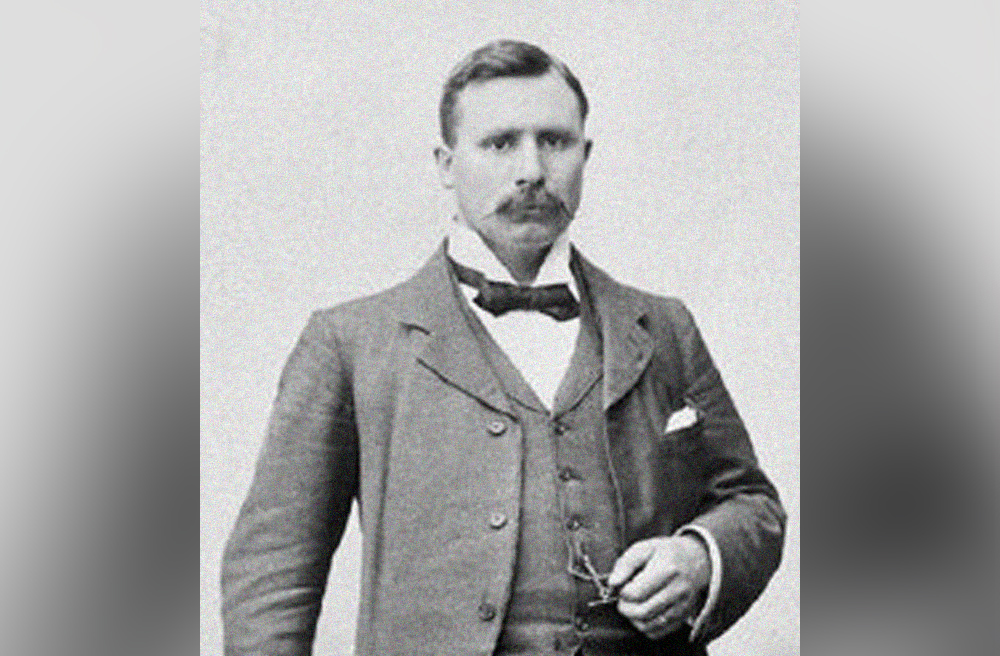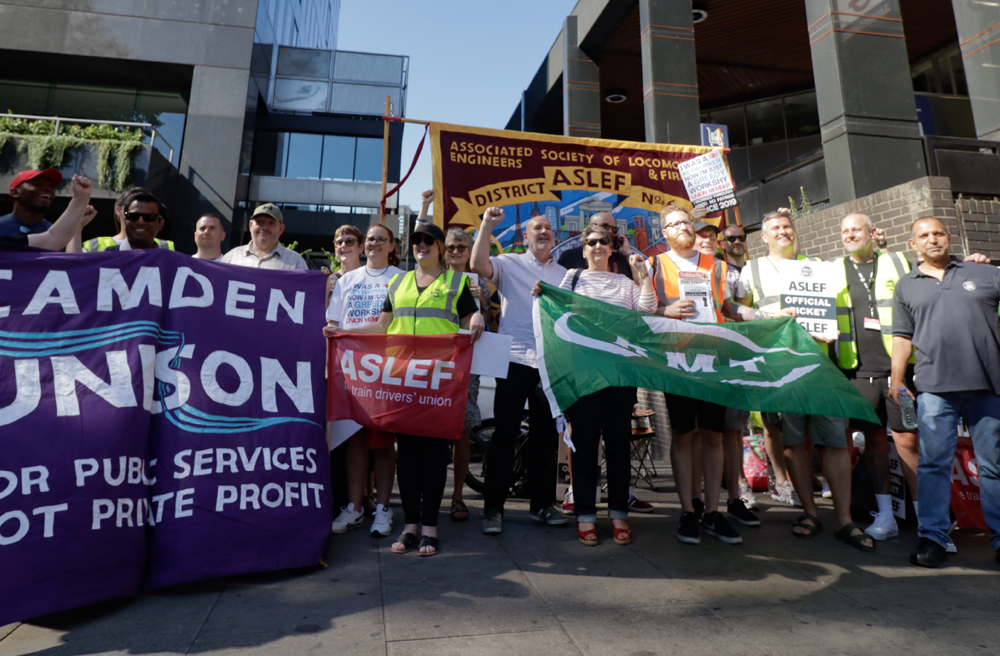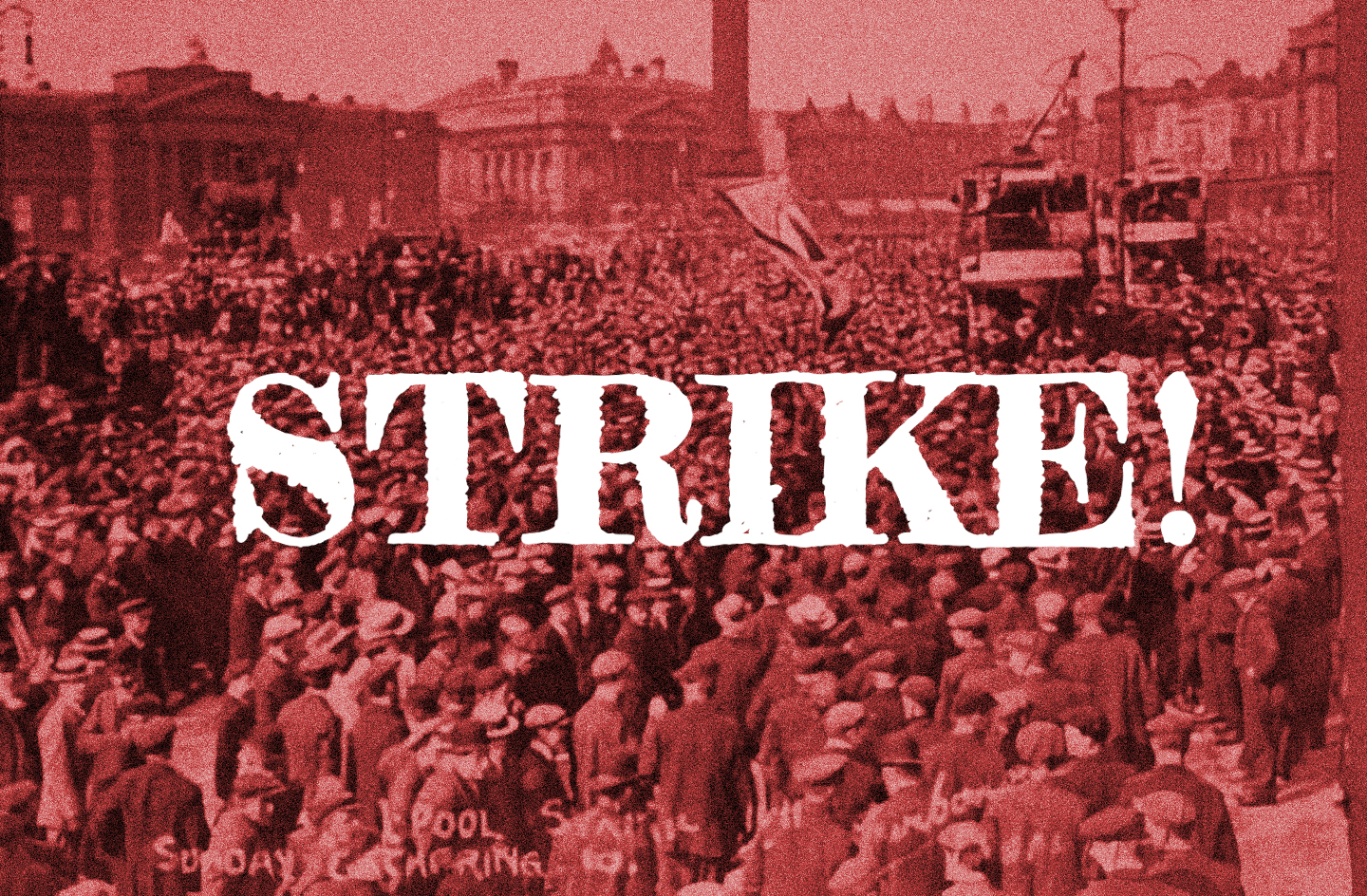Over the summer of 1911, workers in Liverpool brought the city to a standstill. A strike that started in shipping rapidly spread to the docks and all transport. With the class struggle in Britain now heating up, this period contains important lessons for today.
The 1911 General Transport Strike in Liverpool was “as near to revolution as anything I have seen in England”, according to Philip Gibbs, a journalist at the time. The strike, one of the most significant in British history, consisted of many overlapping disputes by ships’ stewards, seamen, dock labourers, carters and railwaymen, to name a few. The strike would last for ten weeks from 14 June until 24 August, when the final group of workers – the dockers – returned to work.
Pay and conditions on the docks were extremely poor because of the casualised nature of the work. The precarity of the employment was summed up by the practice of ‘the stand’, whereby workers would line up outside of the docks in the hope of being selected for work that day. Because there were no contracts, there were no guarantees of work.
Precarity and poverty were further compounded by the local economy being heavily reliant on the docks, with Liverpool possessing only a relatively small manufacturing sector at the time.
Workers either worked on the docks, or in industries that relied on the steady import and export of goods. Put simply, workers in Liverpool were acutely at the mercy of the bosses, and the vicious downturns of capitalism.
Transformation
The strike was a revolt against unscrupulous employers who enforced oppressive discipline amongst their workers. They ruthlessly exploited their casual employees for little pay, and fiercely resisted the rise of the unions.
By 1911 the situation in Liverpool was a combustible mass of social ferment. It was the seamen in the National Sailors and Firemen’s Union (NSFU) and the National Union of Ships’ Stewards, Cooks, Butchers, and Bakers who set it alight. These seamen had developed acute misgivings towards their employers following the outright rejection of their union’s demand for recognition.
Tensions soon reached boiling point. The sailors struck for a pay rise of 10 shillings per week, as well as improvements to their conditions, and for union recognition.
The strike spread like wildfire, with union after union joining in. Huge numbers of formerly unorganised workers took part. Soon commerce in Liverpool came to a standstill and did not move for the whole summer.
Historically, trade unions had struggled to gather momentum on the docks. The bosses’ anti-trade union tactics discouraged workers from organising among themselves. Fear of dismissal, bullying, and oppressive foremen precluded attempts to form unions. With low levels of trade union membership, the employers had been able to rely on blacklegs (scab labour) to undermine industrial action.
The strike underscored a qualitative change in the consciousness of the workers. Undeniably, this was the most powerful strike in the history of Liverpool. It transformed industrial relations in the region overnight.
Such was the militant determination of the workers that it crushed any fear of organising in a union. Employers found that their pool of blacklegs was evaporating, as they rapidly filled the ranks of the unions.
Transport workers were not going to stop until they got a clean break from the past. Solidarity and sympathy strikes were their new weapons of choice. As the socialist historian Eric Taplin remarked about the consequences of the strike: “Liverpool was never the same again.”
Strike
The strike began on 14 June when some 500 firemen refused to sign on for work. This marked the first phase of the conflict that lasted until 4 August, involving seamen, stewards, and catering staff.
Soon, dock labourers and carters in the north end – typically the place where scab labour was recruited – struck in sympathy. This was exclusively a waterfront affair. The National Union of Dock Labourers (NUDL) declared that no cargo on ships owned by companies in dispute with the seamen was to be handled.
As often seen in strikes, sectarianism was temporarily cast aside in favour of class unity. Protestant carters united with the mostly Catholic dockers.
A strike committee chaired by Tom Mann, a giant in Liverpool’s labour history, was set up soon after the strike began.
 A strike committee chaired by Tom Mann, a giant in Liverpool’s labour history, was set up soon after the strike began / Image: public domain
A strike committee chaired by Tom Mann, a giant in Liverpool’s labour history, was set up soon after the strike began / Image: public domain
Mann was one the most prominent advocates of unified action, with the main objective being to unite transport workers at sea with those on land. Already workers had drawn the conclusion that to win they had to unite, and Mann helped give leadership, clarity, and coordination to this.
On 27 June, victory was secured. All involved in this first conflict received a ten shilling per week wage increase, recognition of their unions, the right to wear a union badge at work, and an end to victimisation.
Seamen, firemen, greasers, and donkeymen rushed to join the National Sailors’ and Firemen’s Union, swelling its ranks by 4,500. Meanwhile, the ranks of the steward’s union were filled with previously unorganised catering staff and shore gangs, so that by the end of June the union had taken on 2,500 more workers. Membership to the NUDL rose by 8,000.
This shows how consciousness is transformed through struggle. Superficially it appeared before the strike as though everything was calm, and the bosses had the upper hand. However, beneath the surface, the conditions had been prepared for a massive influx into the unions, once the struggle broke out.
Sympathetic strike
Motivated by these victories, the dock labourers on the north-end docks soon came out on strike on 28 June. They demanded recognition of the NUDL, and union rates of pay and conditions.
Coalheavers in the north-end Canada Dock then came out on sympathy strike. Mann seized upon this opportunity, and – with other members of the strike committee – successfully negotiated full recognition for the union with several employers at that dock.
Following this the dock labourers employed by giant firms such as Cunard, inspired by the victory in the north-end, came out with demands for full union recognition and for exclusive employment of unionised workers. When the bosses refused this, 4,000 dockers then struck.
To add support, some 400 seamen and catering staff struck in sympathy with the dockers. 2,000 Cunard coalheavers marched en masse to the union offices situated in the Canada Dock and signed up to the union in one body. All went out on strike that day. Cold-storage men, and boiler scalers also struck in sympathy, while also pursuing their own wage claims.
With 10,000 workers out on strike by the end of the day, their victory was almost inevitable. All groups involved were simultaneously cashing in their grievances. Pressure from this network of sympathy striking became too great, and the bosses were ground into submission.
Back to work
On 29 June, 1,000 dockers gathered at Sandhills to hear the results of the Strike Commmittee’s negotiations with a committee of employers. Dock workers were permitted to wear the union badge at the stands and at work.
But little was conceded by the employers in terms of pay and conditions. Only the Canada Pacific company had granted both union recognition and full union rates of pay. Large companies, like Cunard, were only willing to go as far as union recognition.
Employers knew that the white heat of class struggle could not last forever and sought to prepare a counter-attack. They knew they had greater resources than the unions, so they sought to burst the energy of the strike and kick the can down the road by reaching an agreement with the strike committee to hold a conference in a month’s time to consider all matters.
Unfortunately, the strike committee played into the hands of the employers, who were clearing playing for time.
This was not enough for workers of the NUDL, who refused to follow the strike committee’s instructions to go back to work, pending the outcome of the conference. Mann’s pleas to the rank and file were initially rejected, and he was heckled as he gave his speech. The workers wanted the immediate implementation of union rates of pay. They saw through this tactic of the employers who wanted the energy of the strike to dissipate.
But by 3 July the strike committee, under pressure from the employers, was able to persuade the workers to go back to work.
Peace and stability, however, did not return to the docks while the dockers waited for the conference. Despite the best efforts of the bosses to kick the struggle into the long grass, the proportion of union representation continued to grow. Workers’ fears and hesitancy were tossed to the wind as the tendency to strike spread.
Throughout July, tugboat men, young workers on passenger ferries, oil mill workers, and women shoemakers at the Walton Rubber Works struck. This highlighted the qualitative change in workers’ consciousness in Liverpool that had spread beyond just the waterfront workers.
Victory
On 4 August, the final meeting of the conference was held and the White Book Agreement detailing the settlement was published.
This marked a tremendous victory for the workers. The dockers and seafarers unions received formal recognition by the employers. And following this, unionised labour was to take preference at the stands, though this was not formally written in the agreement.
As part of the settlement, a joint committee of employer and union representatives was established that was to resolve future disputes through negotiation. This was ultimately to the advantage of the bosses, whose goal was to minimise the amount of days lost to strike action. As part of this compromise, the NUDL agreed to continuity of work while disputes were being resolved through this committee.
Despite this compromise, the settlement brought an end to the domination of the employers over the seafarers.
Struggle spreads
The unrest was yet to reach its pinnacle, however.
Railways workers would strike next, emboldened by the victories they witnessed on the waterfront. The entry of the railway workers would take this struggle to a more volatile, higher level.
On 5 August, an unofficial strike began on the North Docks Depot of the Lancashire and Yorkshire Railway. The employers responded with blacklisting and strikebreaking.
The labour movement hit back with sympathy strikes, and by 8 August all rail traffic at the docks ground to a halt. Immediately the strike committee declared its support and the railway workers joined the strike committee.
An agreement was reached that all transport workers would take sympathetic action. On 9 August, 15,000 goods porters were out, and mass pickets formed outside Central and Lime Street stations.
Shipowners lost all patience with the dockers for their continued sympathetic action. They issued an ultimatum to the NUDL: either control the workers and honour the White Book Agreement, or all operations would be suspended on 14 August. But before it got to this, the brutal hand of the state would inflame the situation to even higher levels.
Bloody Sunday
The ruling class, terrified by the sheer power that workers in Liverpool were displaying, leant on the state and its armed bodies of men. Lord Derby, alarmed at the developments, told the Home Secretary Winston Churchill that ‘a revolution was in progress’.
Churchill responded with brutal repression. Police from Birmingham and London, as well as the armed forces, were drafted in to quash the uprising. Roughly 5,000 troops and 24,000 police were put at the disposal of the head constable.
On 13 August Liverpool would experience its own Bloody Sunday. Police armed with batons, hidden in St. Georges Hall, were set loose upon an 80,000 strong crowd that had gathered outside. Repeated baton-charges left hundreds of men, women and children injured.
This opened up several days of pitched combat between gangs of police, and groups of workers, for control of the streets.
Two days later, two workers, one docker and one carter, were fatally shot by troops after a prison van escorted by troops was held up by a crowd. This shows us that the state has no qualms turning guns on its own citizens when they present too much of a threat to the status quo. Churchill even went as far as placing the gunboat HMS Antrim in the Mersey, with its guns pointed towards the shore.
Rather than quell the movement, the brutal repression merely poured petrol on the fire. Throughout the following week the whole of Liverpool was paralysed.
A general turnout was called for by the strike committee, to which 66,000 workers responded. And on 17 August, a national railway strike was declared, lasting three days. On the same day tramwaymen along with others also employed by the Corporation of Liverpool struck.
A degree of economic control of the city was seized by the strike committee, with the help of the mass pickets. Distribution was controlled by the strike committee who issued milk and bread permits, allowing them to be delivered to hospitals and charitable institutions. This control extended to permitting mail to be sent overseas. Liverpool only moved by the permission of the workers.
This embryonic element of workers’ power terrified the ruling class. Fearful of the movement spreading and taking on revolutionary dimensions, the government intervened in the dispute, effectively forcing the employers to make concessions.
The government strived to bring both employers and unions together to bring about an end to the strike. Shortly after this government intervention, the railway companies met with the union representatives to iron out a settlement. This was followed by the shipping employers who reached an agreement with the NUDL, using the White Book Agreement as the basis for the return to work.
Peaceable relations were cut across briefly on the final day when the Corporation of Liverpool initially refused to reinstate the tramwaymen. They retreated immediately when the strike committee threatened to bring all transport workers back out if the tramwaymen did not get their jobs back. The Corporation immediately backed down.
This shows that despite government intervention pressuring the employers to make concessions, the decisive element of power lay with the organised working class. The dockers finally returned to work on 25 August, thus bringing an end to the General Transport Strike.
Inspiration
As workers today enter ever fiercer class conflict with the bosses, they should look at these events as a source of inspiration and guidance. Within a matter of weeks, the unions were transformed into militant organs of struggle, posing the question: Who runs the city – the bosses or workers?
These events demonstrate a fraction of what the working class is capable of when it becomes conscious of its power. The network of sympathetic striking appeared spontaneously and showcases the organisational capabilities of workers.
 Future events will far outstrip those of 1911. The building of a revolutionary tendency that has a thorough grounding in Marxist theory is more important than ever / Image: Steve Eason, Flickr
Future events will far outstrip those of 1911. The building of a revolutionary tendency that has a thorough grounding in Marxist theory is more important than ever / Image: Steve Eason, Flickr
Because of their tenacity the workers achieved things they had never thought were possible. The strike committee was unaware of the gravity of what they had achieved when they exercised control over distribution. In effect they were acting as an embryonic soviet, implementing the beginnings of worker’s control over Liverpool’s economy.
Today, the material conditions that formed the basis of the strike can be found across the globe. Attacks on pay and conditions, casualisation, and victimisation are plights shared by more workers than at any point in history.
We are in the midst of a hot summer of strikes and struggle. And once again, transport workers are paving the way in this epoch of intensifying class struggle. Workers in the Rail Maritime and Transport union are inspiring millions of others by taking on the bosses.
All workers, not just those in transport, must look to the victories of the past to navigate the way forward. Victory in 1911 resulted from coordinated action that was bolstered by a bold, fighting leadership. Industrial militancy emboldened the rank and file, and inspired unorganised layers to join the fight. These lessons must be taken into the labour movement today.
Future events will far outstrip those of 1911. The building of a revolutionary tendency that has a thorough grounding in Marxist theory is more important than ever – a militant leadership that will boldly fight to secure important concessions and defend workers’ conditions, but also lead the way forward to revolution.
We must do all that we can to ensure that such a leadership is built in advance: a revolutionary leadership befitting of the determination and sacrifice shown by the working class throughout history.

